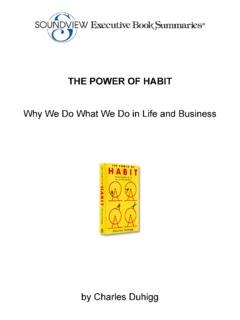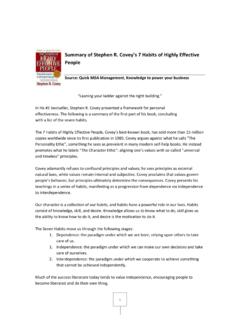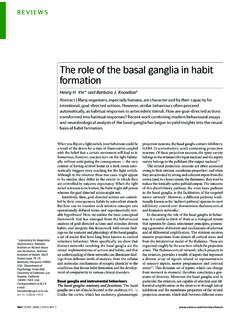Transcription of The Power of Habit - DropPDF
1 The Power of Habit is a work ofnonfiction. Nonetheless, some namesand personal characteristics ofindividuals or events have beenchanged in order to disguise resulting resemblance to personsliving or dead is entirely coincidentaland 2012 by Charles DuhiggAll rights in the United States byRandom House, an imprint of The Random House Publishing Group,a division of Random House, Inc., HOUSE and colophon areregistered trademarks of RandomHouse, of Congress Cataloging-in-Publication DataDuhigg, Power of Habit : why we do whatwe do in life and business / by bibliographical references : 978-0-679-60385-61. Habit . 2. Habit Socialaspects. 3. Change (Psychology) I. dc23 2011029545 Illustration on this page by AndrewPoleAll other illustrations by PageCopyrightDedicationPROLOGUEThe Habit CurePART ONEThe habits ofIndividuals1. THE Habit LOOPHow habits Work2. THE CRAVING BRAINHow to Create New Habits3. THE GOLDEN RULE OFHABIT CHANGE Why TransformationOccursPART TWOThe habits ofSuccessfulOrganizations4.
2 KEYSTONE habits , ORTHE BALLAD OF PAULO NEILLW hich habits Matter Most5. STARBUCKS AND THEHABIT OF SUCCESSWhen Willpower BecomesAutomatic6. THE Power OF ACRISISHow Leaders CreateHabits Through Accident and Design7. HOW TARGET KNOWSWHAT YOU WANTBEFORE YOU DOWhen Companies Predict(and Manipulate) HabitsPART THREEThe habits ofSocieties8. SADDLEBACKCHURCH AND THEMONTGOMERY BUSBOYCOTTHow Movements Happen9. THE NEUROLOGY OFFREE WILLAre We Responsible forOur habits ?APPENDIXA Reader s Guide to UsingThese IdeasAcknowledgmentsA Note on SourcesNotesPROLOGUEThe Habit CureShe was the scientists favorite Allen, according toher file, was thirty-four yearsold, had started smoking anddrinking when she wassixteen, and had struggledwith obesity for most of herlife. At one point, in her mid-twenties, collection agencieswere hounding her to recover$10,000 in debts. An oldr sum listed her longest jobas lasting less than a woman in front of theresearchers today, however,was lean and vibrant, with thetoned legs of a runner.
3 Shelooked a decade younger thanthe photos in her chart andlike she could out-exerciseanyone in the to the most recentreport in her file, Lisa had nooutstanding debts, didn tdrink, and was in her thirty-ninth month at a graphicdesign firm. How long since your lastcigarette? one of thephysicians asked, startingdown the list of questionsLisa answered every time shecame to this laboratoryoutside Bethesda, Maryland. Almost four years, shesaid, and I ve lost sixtypounds and run a marathonsince then. She d also starteda master s degree and boughta home. It had been aneventful scientists in the roomincluded neurologists,psychologists, geneticists,and a sociologist. For the pastthree years, with fundingfrom the National Institutesof Health, they had poked andprodded Lisa and more thantwo dozen other formersmokers, chronic overeaters,problem drinkers, obsessiveshoppers, and people withother destructive habits .
4 Allof the participants had onething in common: They hadremade their lives inrelatively short periods oftime. The researchers wantedto understand how. So theymeasured subjects vitalsigns, installed video camerasinside their homes to watchtheir daily routines,sequenced portions of theirDNA, and, with technologiesthat allowed them to peerinside people s skulls in realtime, watched as blood andelectrical impulses flowedthrough their brains whilethey were exposed totemptations such as cigarettesmoke and lavish researchers goal was tofigure out how habits work ona neurological level andwhat it took to make themchange. I know you ve told thisstory a dozen times, thedoctor said to Lisa, but someof my colleagues have onlyheard it secondhand. Wouldyou mind describing againhow you gave up cigarettes? Sure, Lisa said. Itstarted in Cairo. Thevacation had been somethingof a rash decision, sheexplained.
5 A few monthsearlier, her husband had comehome from work andannounced that he wasleaving her because he was inlove with another woman. Ittook Lisa a while to processthe betrayal and absorb thefact that she was actuallygetting a divorce. There was aperiod of mourning, then aperiod of obsessively spyingon him, following his newgirlfriend around town,calling her after midnight andhanging up. Then there wasthe evening Lisa showed upat the girlfriend s house,drunk, pounding on her doorand screaming that she wasgoing to burn the condodown. It wasn t a great time forme, Lisa said. I had alwayswanted to see the pyramids,and my credit cards weren tmaxed out yet, so .. On her first morning inCairo, Lisa woke at dawn tothe sound of the call to prayerfrom a nearby mosque. It waspitch black inside her hotelroom. Half blind and jet-lagged, she reached for was so disoriented thatshe didn t realize until shesmelled burning plastic thatshe was trying to light a pen,not a Marlboro.
6 She had spentthe past four months crying,binge eating, unable to sleep,and feeling ashamed,helpless, depressed, andangry, all at once. Lying inbed, she broke down. It waslike this wave of sadness, she said. I felt likeeverything I had ever wantedhad crumbled. I couldn t evensmoke right. And then I startedthinking about my ex-husband, and how hard itwould be to find another jobwhen I got back, and howmuch I was going to hate itand how unhealthy I felt allthe time. I got up andknocked over a water jug andit shattered on the floor, and Istarted crying even harder. Ifelt desperate, like I had tochange something, at leastone thing I could control. She showered and left thehotel. As she rode throughCairo s rutted streets in a taxiand then onto the dirt roadsleading to the Sphinx, thepyramids of Giza, and thevast, endless desert aroundthem, her self-pity, for a briefmoment, gave way.
7 Sheneeded a goal in her life, shethought. Something to she decided, sitting inthe taxi, that she would comeback to Egypt and trekthrough the was a crazy idea, Lisaknew. She was out of shape,overweight, with no money inthe bank. She didn t know thename of the desert she waslooking at or if such a tripwas possible. None of thatmattered, though. She neededsomething to focus on. Lisadecided that she would giveherself one year to to survive such anexpedition, she was certainshe would have to particular, she wouldneed to quit Lisa finally madeher way across the deserteleven months later in anair-conditioned andmotorized tour with a half-dozen other people, mind you the caravan carried somuch water, food, tents,maps, global positioningsystems, and two-way radiosthat throwing in a carton ofcigarettes wouldn t havemade much of a in the taxi, Lisa didn tknow that.
8 And to thescientists at the laboratory,the details of her trek weren trelevant. Because for reasonsthey were just beginning tounderstand, that one smallshift in Lisa s perception thatday in Cairo the convictionthat she had to give upsmoking to accomplish hergoal had touched off aseries of changes that wouldultimately radiate out to everypart of her life. Over the nextsix months, she would replacesmoking with jogging, andthat, in turn, changed how sheate, worked, slept, savedmoney, scheduled herworkdays, planned for thefuture, and so on. She wouldstart running half-marathons,and then a marathon, go backto school, buy a house, andget engaged. Eventually shewas recruited into thescientists study, and whenresearchers began examiningimages of Lisa s brain, theysaw something remarkable:One set of neurologicalpatterns her old habits hadbeen overridden by newpatterns. They could still seethe neural activity of her oldbehaviors, but those impulseswere crowded out by newurges.
9 As Lisa s habitschanged, so had her wasn t the trip to Cairothat had caused the shift,scientists were convinced, orthe divorce or desert trek. Itwas that Lisa had focused onchanging just one Habit smoking at first. Everyonein the study had gone througha similar process. By focusingon one pattern what isknown as a keystonehabit Lisa had taughtherself how to reprogram theother routines in her life, s not just individualswho are capable of suchshifts. When companies focuson changing habits , wholeorganizations can such as Procter &Gamble, Starbucks, Alcoa,and Target have seized onthis insight to influence howwork gets done, howemployees communicate, and without customersrealizing it the way peopleshop. I want to show you one ofyour most recent scans, aresearcher told Lisa near theend of her exam. He pulledup a picture on a computerscreen that showed imagesfrom inside her head.
10 Whenyou see food, these areas he pointed to a place near thecenter of her brain whichare associated with cravingand hunger, are still brain still produces theurges that made you overeat. However, there s newactivity in this area hepointed to the region closestto her forehead where webelieve behavioral inhibitionand self-discipline starts. Thatactivity has become morepronounced each time you vecome in. Lisa was the scientists favorite participant becauseher brain scans were socompelling, so useful increating a map of wherebehavioral patterns habits reside within our minds. You re helping usunderstand how a decisionbecomes an automaticbehavior, the doctor told in the room feltlike they were on the brink ofsomething important. Andthey you woke up thismorning, what did you dofirst? Did you hop in theshower, check your email, orgrab a doughnut from thekitchen counter?



















